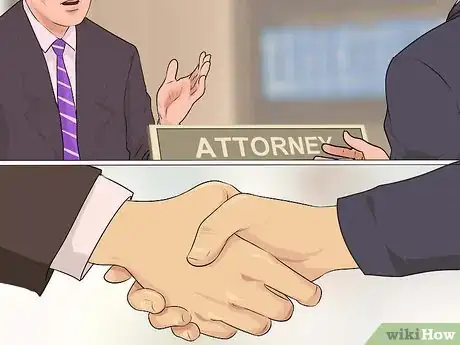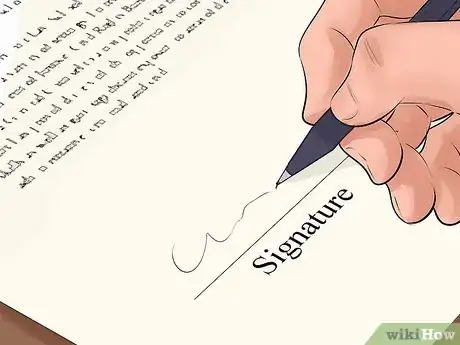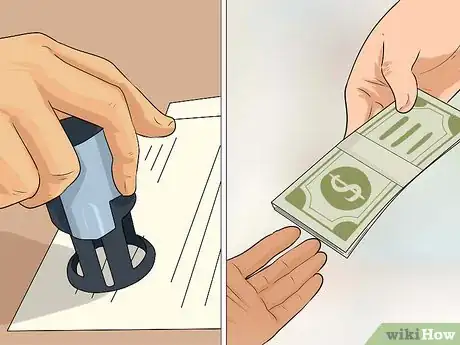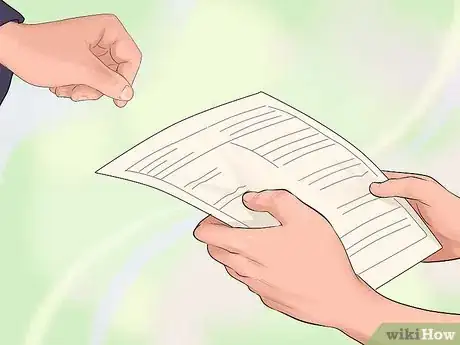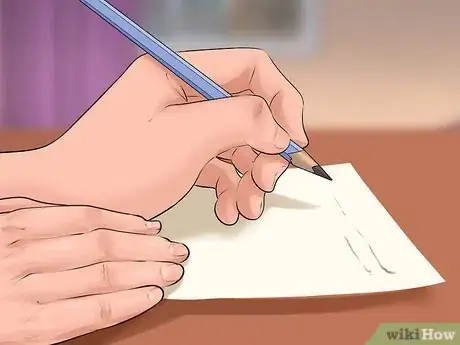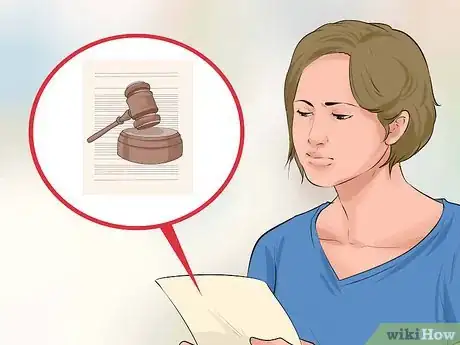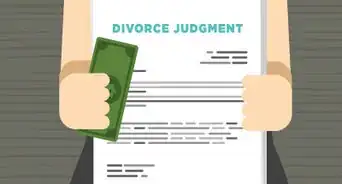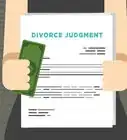This article was co-authored by Clinton M. Sandvick, JD, PhD. Clinton M. Sandvick worked as a civil litigator in California for over 7 years. He received his JD from the University of Wisconsin-Madison in 1998 and his PhD in American History from the University of Oregon in 2013.
This article has been viewed 90,783 times.
If you and your spouse no longer want to be married to one another, you can legally end your marriage through a divorce. In Connecticut, the legal word that is used for divorce is “dissolution.” If you and your spouse agree on the issues related to your separation, you may be able to represent yourself as a “pro se” party. However, if you disagree with your spouse about child custody, separation of property or other important issues, you should hire an attorney before proceeding.
Steps
Qualifying to get Divorced in Connecticut
-
1Meet the residency requirement. In order to get a divorce in Connecticut, either you or your spouse must have lived continuously in Connecticut for 12 months prior to the date that the court issues the dissolution judgment. You may file for divorce before you or your spouse has lived in Connecticut for 12 months, as long as you will meet the 12-month residency requirement on the date that the divorce judgment is issued.
- Usually, the divorce process will take a minimum of 3 months, therefore, if you have lived in Connecticut for 9 months before you file, you should meet the residency requirement at the time the divorce is completed.
- If neither you nor your spouse has lived in Connecticut long enough to meet the residency requirements, you may still get divorced in Connecticut if the reason for the divorce arose after you and your spouse moved to Connecticut, if you can’t meet the requirements because you are in the military, or if you were a Connecticut resident in the past, and moved back with the intention of making Connecticut your permanent residence.
-
2Consider your grounds for divorce. Spouses in Connecticut do not need to prove "grounds" in order to obtain a divorce. The court will issue a divorce on the ground that the marriage has "broken down" with no hope for a reconciliation. People refer to this as a "no-fault" divorce.
- If your spouse did something wrong, such as committing adultery or abandoning you, the court can consider your spouse’s actions when determining how to divide property or whether alimony is appropriate.
- Usually, it is only helpful to bring the court’s attention to your spouse’s misconduct if the misconduct caused a loss of marital property.
Advertisement -
3Find out where to file. You must file a petition for divorce in the county where you live. This county is where your divorce hearings will take place, and where you will turn in all of your paperwork.
- To find the location of the courthouse that serves your county, visit Connecticut’s Judicial Branch Website at http://www.jud.ct.gov/.
Considering the Issues Present in a Divorce
-
1Determine how your property may be divided. Connecticut courts will “equitably distribute” property when a couple divorces. “Equitable distribution” means that the court can distribute all property that either spouse or both spouses have, regardless of whose name it is in and when the property was acquired. [1]
- Property that the court can divide between the parties or award to one party includes: the marital residence, stock options owned by one party, personal injury awards (including workers compensation), inheritance, gifts given to one party, 401k payments and pensions, any property acquired by one or both spouses during the marriage, and property acquired by one or both spouses before the marriage.
- When determining how to divide the property, the court will consider the following: the length of the marriage, the cause of the divorce, the age, health, station, occupation, amount and sources of income, earning capacity, vocational skills, education, employability, estate, liabilities and needs of each party, and contributions of each party to the marriage. [2]
-
2Talk to your spouse about child custody and support, if you have children. If you and your spouse have children, the court will come up with a custody arrangement that is in the “best interests of the child.” This could mean that you and your spouse will share custody, or the court could award one party full custody. Additionally, you and your spouse will have to determine each party’s child support obligations based on how the court determines custody.
- In determining custody, the court will consider the preference of the child, as long as he or she is old enough (in the court’s opinion) to form an intelligent opinion. However, the judge does not have to listen to the child’s preference.
- Typically, spouses should try to agree on a shared custody agreement, because that is usually in the best interests of the child.
- In order to be granted a divorce, both parents must take a “parenting education class” that is provided by the court. [3] The course is $125 per person and lasts for 6 hours.
-
3Consider whether you or your spouse will be asking for spousal support. In Connecticut, either spouse may ask for continued support from the other, but no one is absolutely entitled to support. The court will consider many factors when determining whether to award support payments, including the length of the marriage and the earning potential of the spouse who is asking for alimony.
- The court will determine whether support is appropriate based on all of the facts and circumstances surrounding the parties. There is no formula that is used to determine how much payments will be.
- The court can award support to be paid in a lump sum (all at one time), periodically for a pre-determined temporary amount of time, or permanently.
Finding an Attorney
-
1Determine whether you need an attorney. While having an attorney to advocate on your behalf may insure that the divorce process goes smoothly, you may be able to complete the divorce without a lawyer.
- If you and your spouse agree on how to divide your property, and if you there are no children involved, you can probably file for divorce on your own and save money. If you do not have an attorney, you and your spouse will be responsible for filing all of your paperwork, and will each talk to the judge without getting any help preparing.
- If you and your spouse do not agree on how to separate your property, or if you have children and need to come up with a custody arrangement, you should hire an attorney to assist you. A “contested” divorce where the parties do not agree can be extremely complicated, and you should have an expert to help you get the best possible outcome.
-
2Research local attorneys. If you decide to hire an attorney, you should research possible candidates to find one that is right for you. To begin the process, considering doing the following:
- Get a referral from a friend or family member who has used a divorce lawyer before. Find out who they hired and if they would recommend the attorney. If you can’t get a referral from anyone you know, check online websites like Find Law, Avvo, and Yahoo Local to find a qualified attorney.
- Once you have a list of attorneys that you think may be a good fit, set up “consultation” meetings so you can meet face to face. During the meeting, you can ask questions about your case and situation, and gauge whether you get along with the attorney.
-
3Choose the right attorney for your situation. After meeting with potential attorneys, decide which one is the best for your particular situation. You should consider the amount of experience the attorney has, the price he or she will charge, and how well you got along with the attorney.
- If, after meeting with an attorney, you think of other questions you would like to ask, don’t hesitate to call back and ask. You should make an informed decision, and the attorney that you are considering should not have any problem answering any and all questions that you may have.
- If you cannot afford an attorney, you can try to obtain legal help on a “pro bono” (free) basis. To see if you can get free legal help, you may call “Statewide Legal Services” at 1-800-453-3320. The people who answer the telephone speak both English and Spanish. [4]
Preparing and Filing your Divorce Petition
-
1Fill out the required forms. To start a divorce, you will need three court forms: the Summons Family Actions, the Divorce Complaint, and the Notice of Automatic Court Orders. You can find all of these forms by visiting the Connecticut Judicial Branch Website and downloading the forms you need. [5]
- Summons: Having a "summons" delivered to your spouse by a state marshal is intended to notify your spouse that you are filing for a divorce. After receiving a summons, your spouse should file an Appearance form, which allows he or she to respond to the divorce action. Failure to file an appearance form will result in your spouse not getting notice of the required court dates for your divorce, and may slow down the divorce process. Do not sign the summons until you are in front of the court clerk to turn in all of your documents. [6]
- Divorce Complaint: The complaint tells the court what you want out of the divorce. You can ask the court to do the following for you in a divorce: end your marriage, give you financial support from your spouse (alimony), give you custody of or visitation with any marital children, give you child support, divide marital property between you and your spouse, or restore your prior name. If you are the party filing for the divorce, you should check the "complaint" box at the top of the form. If your spouse chooses to respond to your allegations, he or she will fill out the same form, but will check the box for "cross complaint." (which can be used by the spouse who does not file for divorce). [7]
- Notice of Automatic Court Orders: You should attach a completed copy of this notice to your “divorce complaint.” this “order” will take effect when you file your divorce paperwork, and will protect you and your spouse by setting rules that will apply during the divorce proceedings. For example, this order will prevent one spouse from selling the marital home, or from taking any children out of the state. [8]
-
2Sign the divorce paperwork in the presence of the clerk. Once you have prepared the paperwork, you should take it to the clerk in the county where you live to sign it. This will start the divorce process. The clerk of court will sign you summons, and will additionally act as a “witness” for you signing the summons and paperwork. After you sign the paperwork, the court clerk will give you copies to “serve” on your spouse.
-
3Pay the filing fee. When you sign and file your paperwork, you will be required to pay a fee that covers the costs of your divorce. In Connecticut, the total fee for getting a divorce is $525. This includes a $350 “court filing fee,” a $50 fee for serving court papers on your spouse (which you will pay to the state marshal), and $125 for the required parenting education class. Additionally, if you do not know the location of your spouse to serve the divorce papers, you must pay an extra $350 in order to publish a notice in a newspaper. [9]
- If you cannot afford to pay the court fees, you can fill out an Application for Waiver of Fees. This form asks for information about your income and expenses to show the court why you cannot afford to pay the costs associated with the divorce. Do not sign the form until you are in front of a court clerk. A judge will review your application and decide whether or not to grant it.
-
4Give your spouse “notice” of the action. After you sign your divorce paperwork, you are required to give your spouse “notice” of the divorce before you file. This is so your spouse knows about the required court dates, and so that your spouse can “answer” your complaint with his or her own.
- To serve your spouse, Contact a state marshal in the judicial district where your spouse lives or works. You may get a list of state marshals from the court clerk or the Court Service Center.
- After contacting the marshal, you should bring the documents given to you by the clerk to the marshal, along with the $50 fee.
- The marshal will serve your spouse, and then file a “Return of Service” as proof. Either you or the marshal will file the return of service with the court.
-
5File your paperwork. The original Summons, Complaint, Notice of Automatic Court Orders, state marshal’s return of service and the filing fee (or the original Application for Waiver of Fees if it was granted by the judge) must be brought or mailed to the court clerk’s office to “file.”
- If you do not have a fee waiver, you will pay the $350 filing fee when you file your paperwork.
- Make sure to check with the court to see what forms of payment are accepted: some courts allow payment by credit card, but others only allow cash or check.
-
6Wait for your spouse to file an “appearance form,” “answer,” or “cross complaint.” Once your spouse has been served with the divorce papers, he or she will have the opportunity to respond. Your spouse can file an “appearance form,” “answer,” “cross complaint” or all three. [10]
- Appearance: The spouse who did not file for divorce must file an “appearance” form. This form gives the court information about the filing party and insures that he or she receives notice of all important dates and any hearings or required appearances.
- Answer: An answer is not required, but the responding party can file it to tell the court whether or not he or she agrees with the complaint. There is no filing fee for submitting an answer.
- Cross Complaint: A cross complaint is not required, but should be filed if the responding spouse wants something different than the filing spouse listed in the complaint. The “cross complaint” form is the same as the “complaint” and allows the responding spouse to request alimony, child custody, visitation, or child support. It can also request that the court divide your property and debts a certain way, or restore a prior name.
-
7Comply with the automatic orders. Filing divorce papers triggers certain automatic court orders that protect you, your spouse and any children during the divorce. If you are the party that filed for divorce, the automatic orders apply to you when you sign the complaint. If you are the responding party, the automatic orders apply to you when you are served with the summons and complaint. [11]
- Once the automatic orders take effect, you may not go into unreasonable debt, sell your property without your spouse’s agreement, change medical or life insurance coverage, or force your spouse to leave your home. [12]
- If you have children, automatic orders prevent you from moving your children out of state and require you to take part in a parenting education program. [13]
-
8Go through the required 90 day waiting period. You must wait at least 90 days after your divorce action starts to get a judgment of divorce. During the waiting period, you should try to reach an agreement with your spouse on the financial issues and issues about your children. A private mediator or a family relations counselor from the Judicial Branch’s CSSD Family Services Office may be able to help you reach an agreement. To find out if the court you filed in offers any resources for helping you and your spouse, contact the clerk of court. [14]
- If you and your spouse do come to an agreement, fill out the Dissolution Agreement Form with your spouse. This form reduces the agreement you have to writing for the court to look at and approve.
- During the waiting period, you and your spouse should fill out the Case Management Agreement Form. This form allows you to choose the status of your divorce. The divorce will be “uncontested” if you and your spouse agree on all issues, and “contested” if you do not come to an agreement. After filling out and turning in the Case Management Agreement Form, the court will set a hearing for your divorce.
Finalizing Your Divorce
-
1Fill out forms for your “uncontested divorce hearing.” If your divorce is uncontested, you and your spouse should fill out the forms that will be required at the divorce hearing. The following form must be completed or filed before your hearing date. [15]
- Financial Affidavit: Both you and your spouse must fill out a form containing information about your finances. This form must be filed with the court at least 5 days and not more than 30 days before your court hearing. This form must be signed in front of a notary public, an attorney, or a court clerk. Financial Affidavits are sealed by the court when they are filed and, unless the court orders differently, can be shown only to the judge and other court personnel.[16]
- Additionally, if you and your spouse have children, you may be required to fill out other forms in addition to the financial affidavit.
-
2Attend your divorce hearing. The final step in the divorce process is the “divorce hearing.” Take the filled out forms listed above with you to court on the day of your divorce hearing. If your divorce is uncontested, you will simply give your forms to the judge to look over, and then he or she will approve them if satisfied. Additionally, the judge may ask you questions about the information contained in your divorce agreement. If your divorce is contested, the judge will give you instructions on how to proceed, and may decide on the issues i your divorce during this hearing, or at a later date. [17]
- Make sure you are on time to your hearing, judges often hear more than one divorce at a time, so you do not want to hold everyone up.
- If the judge asks you any questions, address him or her as “your honor” and make sure to be polite and respectful.
-
3Comply with any court orders. After your divorce hearing, the judge will enter a "final decree of divorce" that will be kept on file. This "final decree" will spell out the conditions of your divorce as agreed to by you and your former spouse. It is extremely important that you comply with the terms of the agreement.
- Because the decree is the "law" of your divorce, not following it can result in serious consequences, including penalty fees or in some cases, jail time.
- If there is something in your divorce decree that you would like to change, call the clerk's office and ask what you should do in order to "modify the order."
References
- ↑ Conn. Gen. Stats. § 46b-81
- ↑ Conn. Gen. Stats. § 46b-81
- ↑ Conn. Gen. Stats. § 46b-69b
- ↑ https://www.jud.ct.gov/Publications/FM179.pdf
- ↑ https://www.jud.ct.gov/Publications/FM179.pdf
- ↑ https://www.jud.ct.gov/Publications/FM179.pdf
- ↑ https://www.jud.ct.gov/Publications/FM179.pdf
- ↑ https://www.jud.ct.gov/Publications/FM179.pdf
- ↑ https://www.jud.ct.gov/Publications/FM179.pdf
- ↑ https://www.jud.ct.gov/Publications/FM179.pdf
- ↑ https://www.jud.ct.gov/Publications/FM179.pdf
- ↑ https://www.jud.ct.gov/Publications/FM179.pdf
- ↑ https://www.jud.ct.gov/Publications/FM179.pdf
- ↑ https://www.jud.ct.gov/Publications/FM179.pdf
- ↑ https://www.jud.ct.gov/Publications/FM179.pdf
- ↑ https://www.jud.ct.gov/Publications/FM179.pdf
- ↑ https://www.jud.ct.gov/Publications/FM179.pdf
About This Article
Getting a divorce can be stressful, but if you agree on the terms of separation and file the right paperwork with the Connecticut court system, it should be a smoother process. First, sit down and decide how you want to divide your property and assets. If you have children, you’ll need to decide on custody arrangements and child support payments. Keep in mind, you’ll also need to take a 6-hour parenting course with the court. If you can’t agree on the division of your assets or child arrangements, get an attorney to help you negotiate it. Once you’ve settled on your terms, get the 3 forms you need from the Connecticut Judicial Branch website, which are the Summons Family Actions, the Divorce Complaint, and the Notice of Automatic Court Orders. After you’ve filled them out, file the forms with your local county clerk and pay the fees of $525. After the required 90 day waiting period, you’ll need to fill out uncontested divorce hearing forms and take them to your hearing date. For more Legal advice, including how to pick a good attorney, read on.






